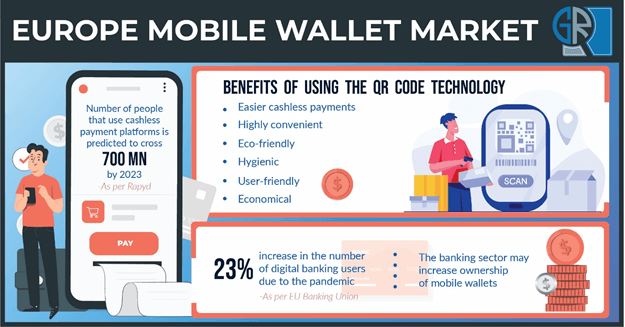Europe mobile wallet market size is expected to grow at a notable rate during the forecast period of 2020-2026. The region is witnessing a substantial rise in the use of mobile wallets as a major part of the population is demanding digital payment platforms.
According to an article by Rapyd, the value of digital and mobile payment transactions in Europe grew by more than 30% since 2018. In addition, the number of people that use cashless payment platforms is predicted to cross 700 million by 2023.
The European Commission, in June 2021, announced its plans to launch a digital identity wallet, which is a mobile application that can help people store all kinds of official documents and electronic identification forms. These include driver’s license, bank account documents, and diploma certificates. Such initiatives will surely boost the utilization of mobile wallet solutions in Europe.
Some of the widely used digital wallet apps in Europe include PayPal, Samsung Pay, and ApplePay. In fact, PayPal is the go-to digital wallet for 70% consumers in Germany. However, there are other apps that are also extensively used in many countries across the region.
For example, Russia mainly uses YooMoney and Qiwi for digital payments, while in the Netherlands, iDEAL is a popular mobile wallet. While some nations still accept card or cash as a payment method, the concept of mobile wallets is likely to pick up the pace in these countries in the future.

QR codes gain traction among end-users:
The QR code technology is likely to capture a sizeable share of Europe mobile wallet market by 2026. One of the major reasons behind this is the growing use of this technology in several sectors. Nearly 14.1% of users in Europe have QR code scanners installed in their smartphones.
Moreover, Spain saw a 9% rise in the number of QR code scanners in recent years. Many sectors like transportation have started using the QR code on a large scale. For example, the RATP system in Paris is extensively using QR codes at bus stops. There are many benefits of using the QR code technology, such as easier cashless payments, highly convenient, eco-friendly, hygienic, user-friendly, and economical, which will favor its use among end-users.
Open e-wallets may be highly used in Europe:
Europe market size from open e-wallets will grow at an appreciable rate during the forecast timeframe of 2020-2026. The region has several companies that offer mobile wallets to their clients to make it easier for them to carry out a wide range of transactions. The banking sector in Europe is witnessing a robust transformation due to the introduction of innovative technologies.
The COVID-19 pandemic acted as a catalyst for increasing the use of digital banking platforms among customers. In fact, the pandemic caused a 23% increase in the number of digital users. This has created a fundamental operational change in the banking sector, thereby driving the issuance of open mobile wallets.
Only banks and related institutes are authorized to issue open e-wallets, which can allow clients to make payments or withdraw funds in cash from ATMs. This feature adds to their convenience, thereby augmenting the adoption of open mobile wallets among customers.
The banking sector may increase ownership of mobile wallets:
The banking sector is projected to hold a significant share of Europe mobile wallet industry by 2026 as the concept of digitization is gaining momentum in the sector. Traditional banks are facing stiff competition from their counterparts who have switched to digital payment methods. Since customers are demanding convenience in their banking activities, the need for digital banking services is bound to rise. With the help of open e-wallets, customers can easily transfer funds to their families and friends and withdraw money from the ATM, which may prompt banks to further promote the use of digital payment options like mobile wallets.
Several sectors in Europe are undergoing digitization to cater to the customers’ increasing demand for convenient and timely services. The introduction of mobile wallets has surely made life much easier for the millennial generation as they are using this payment method at various places, such as restaurants, banks, hospitals, and retail stores.
Reputed organizations across Europe, such as Allied Wallet, Inc., Apple Inc., Samsung Electronics Co. Ltd., AT&T Inc., Amazon.com, Inc., American Express Company, J.P. Morgan Chase & Co., Google LLC, Mastercard Incorporated, and PayPal Holdings, Inc., among many others, are intensifying their research and development efforts to launch innovative technologies in their mobile wallets. They are also entering into partnerships and merger & acquisition deals with other companies to increase their customer base and enhance their product & service portfolios.
For example, In September 2020, Visa and Norway-based Vipps announced a strategic partnership to promote digital payments in Europe. This deal will allow Visa’s clients and partners to use the Vipps platform to create their own mobile wallets and provide customers with a wide range of payment options and effectively manage their funds.
COVID-19 impact on the use of mobile wallets in Europe:
The COVID-19 pandemic accelerated the use of mobile wallets in many countries across Europe as the region was among the worst-affected by the virus and people had to take care of their daily necessities. Since the regional population was skeptical to go out and shop for groceries, several companies introduced mobile wallets to facilitate easier and contactless payments.


